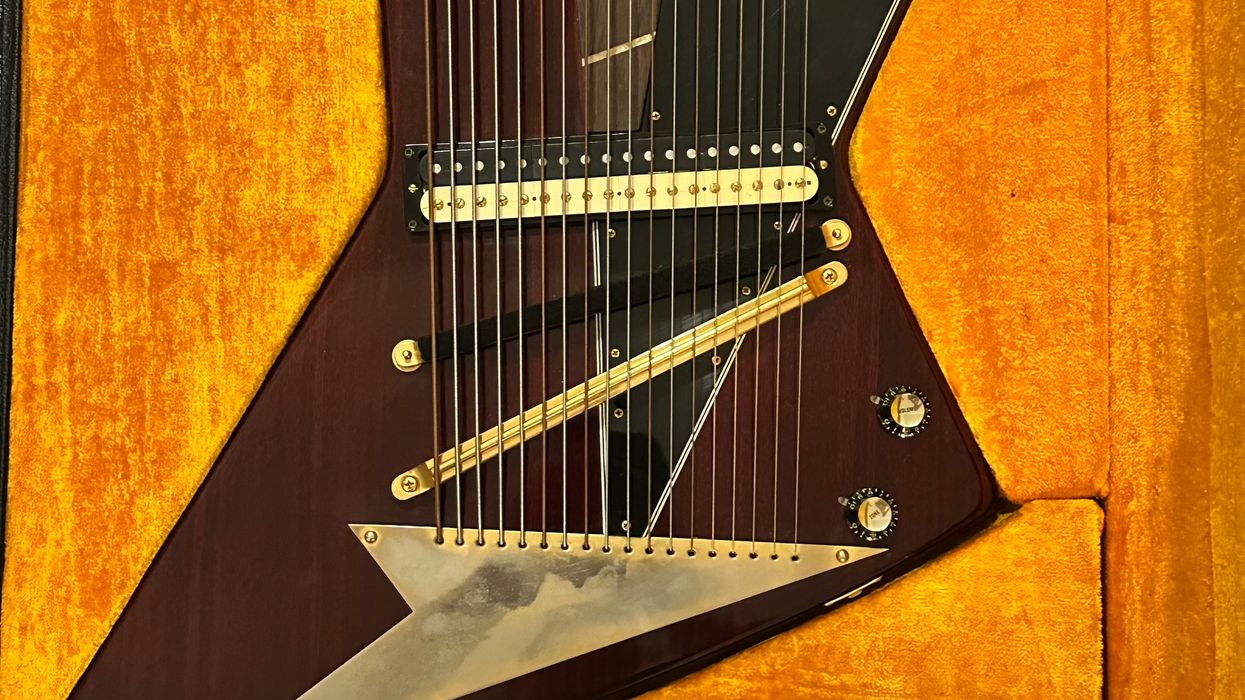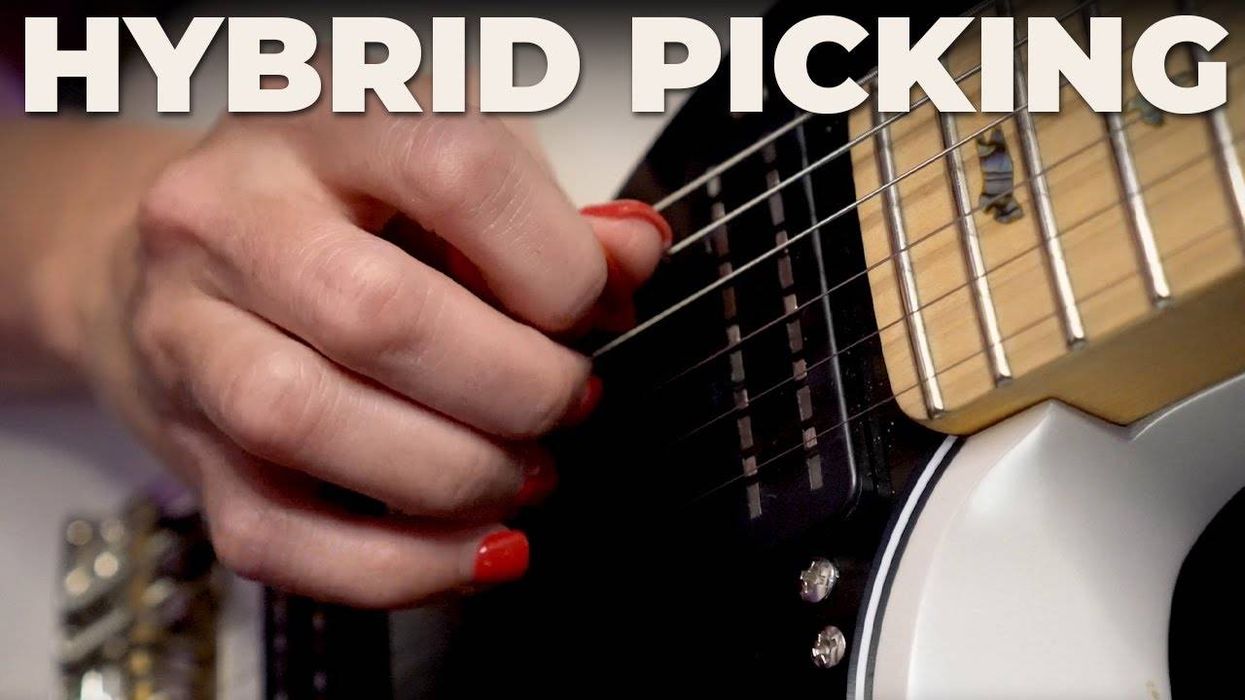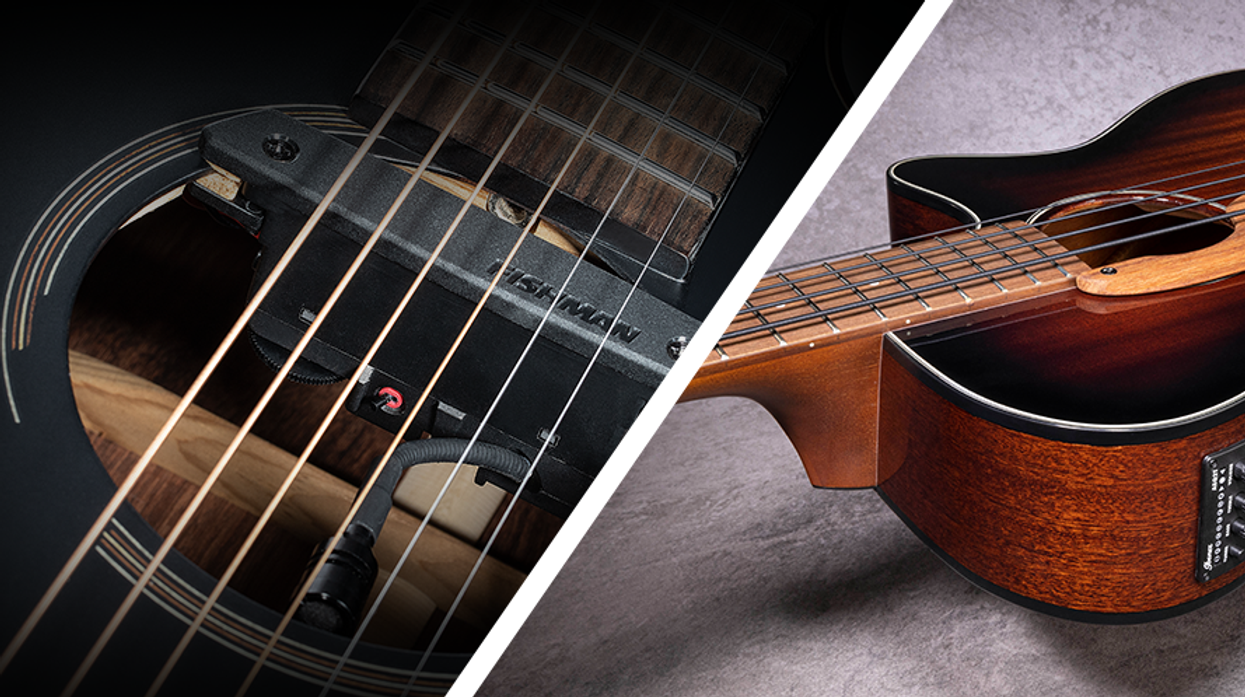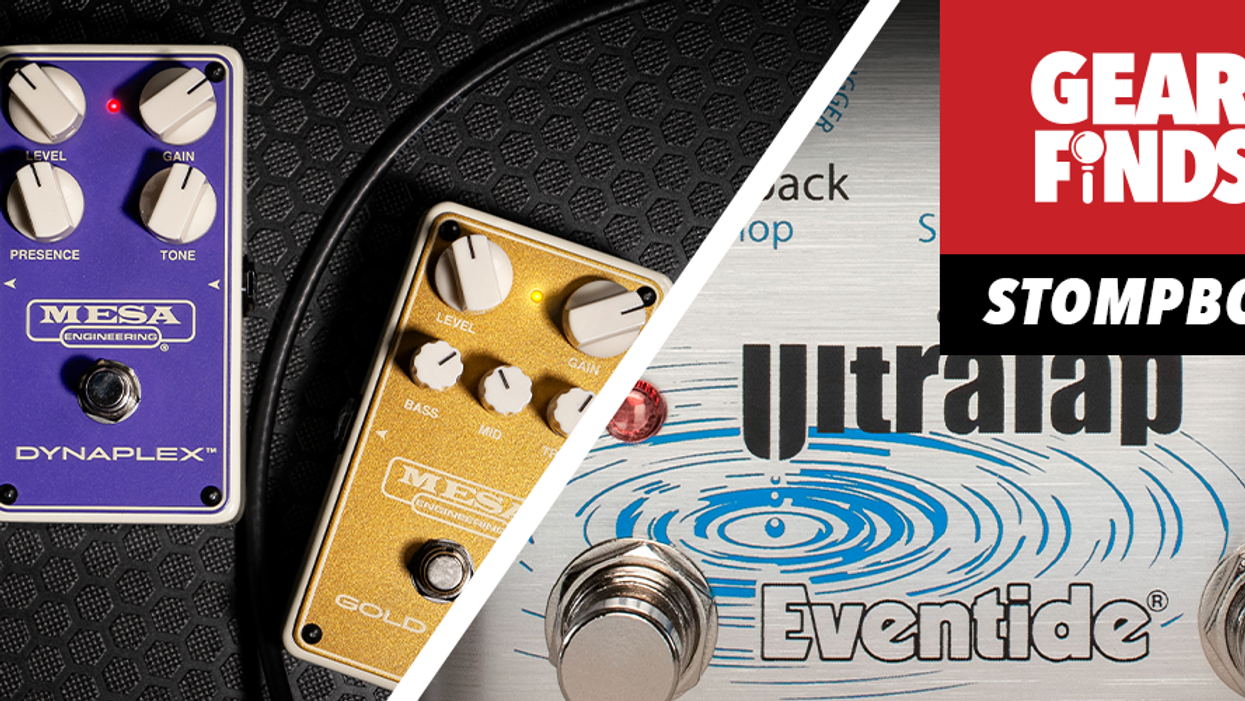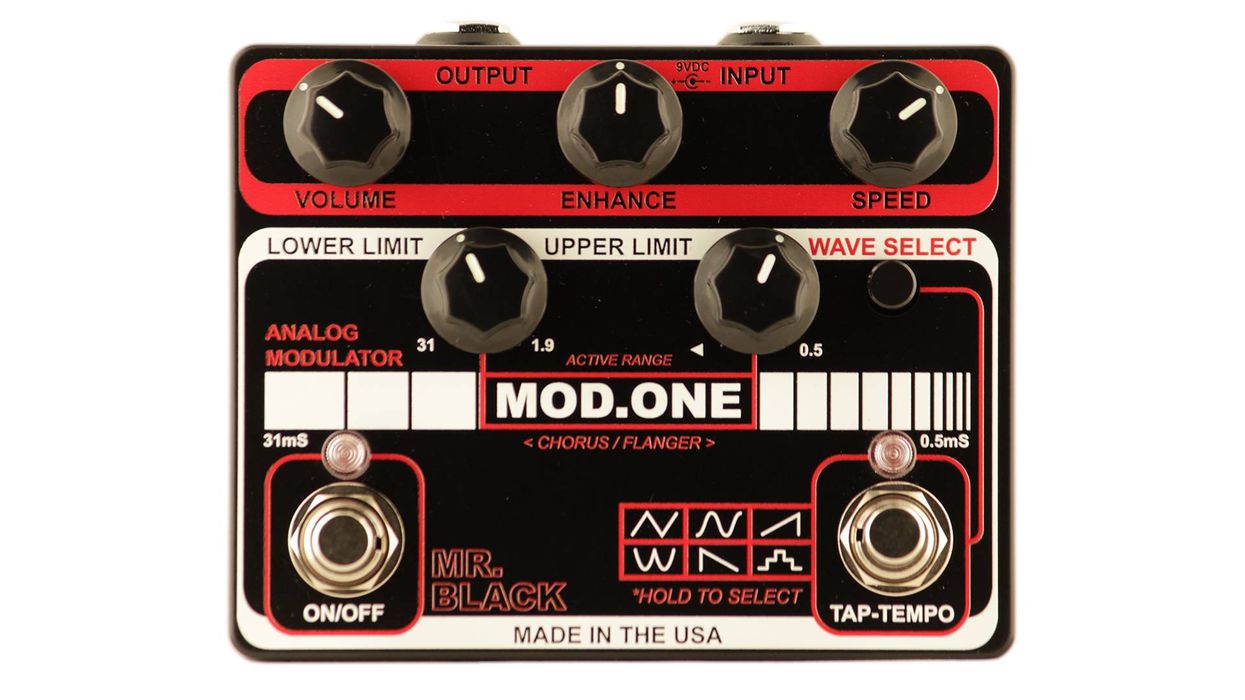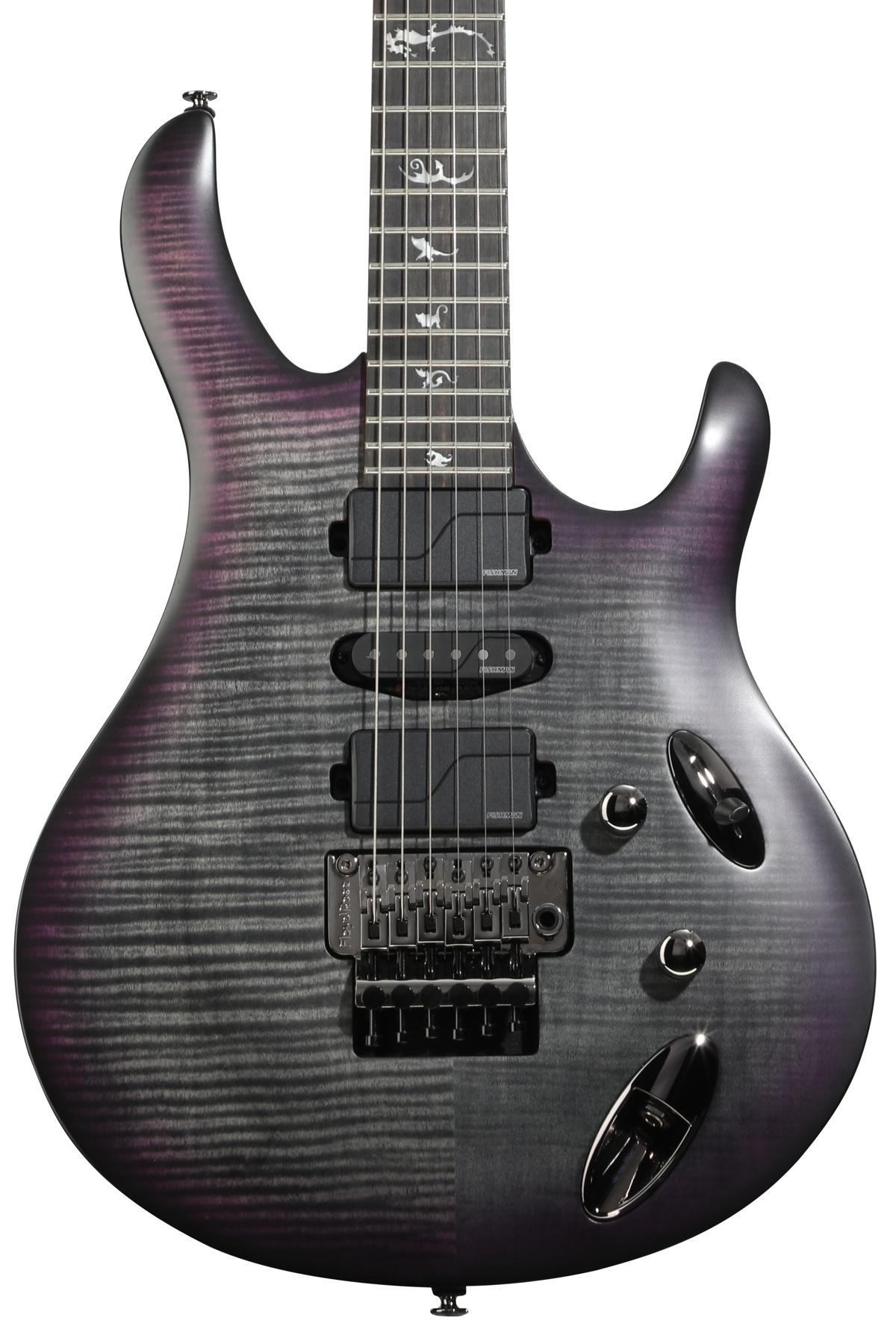Dave Timnick rips a note behind the nut on his Dunable Yarnhawk during Intronaut’s opening set for progressive juggernauts Animals As Leaders and Swedish metallers Meshuggah in 2013 at the Wiltern Theater in Los Angeles.
Photo by Lindsey Best
Intronaut’s guitarists—dual fire-breathers Dave Timnick and Sacha Dunable—want you to know that “technical” is not a musical genre.
“No one gets into music because it’s technical or because they want to be technical,” says Timnick, singer and 6-stringer for the innovative metal band. “People get into music because of an emotional response and release. It’s funny when people think we’re big technical nerds that count out every note of every bar of our music.”
And while they’re clearing the air on labels the band isn’t thrilled to have thrown at them, let’s touch on “progressive.”
“I think our definition of ‘progressive’ has always been different than most people’s,” says Dunable. “We consider anything with an innovative spirit behind it to be progressive. It has very little to do with what shape or sound a song takes and everything to do with translating the insane noises in your head into music. Just like our favorite records growing up, it’s supposed to be challenging, but still get stuck in your head.”
Vague adjectives aside, Intronaut further progressed—err, evolved—while creating their fifth long player, The Direction of Last Things. They tracked the album as a live band—aside from vocals and overdubs—in less than four days. They hired metal mastermind Devin Townsend (who’s produced Lamb of God, August Burns Red, and Gwar—along with his own albums) to mix it. And it was their first album using Dunable’s own hand-built guitars through Mesa/Boogie Royal Atlantic heads. The result is the band’s tightest, biggest-sounding recording.
Musical departures and new flavors on their latest include “The Unlikely Event of a Water Landing,” a melody driven and collage-like track that recalls Alice in Chains’ Dirt—especially in its solo section. There’s also Timnick’s fretboard tapping and Dunable’s rhythm-building-block use of a looper that propels the opening and closing of “Digital Gerrymandering,” and, in general, there’s widespread use of cleanly sung vocals.
When bands speak of evolution, it often frightens fans. But rest easy, Intronaut’s genome of brutal, sprawling riffs thunders through “The Pleasant Surprise,” and their diabolically complicated jazz-fused jams send up a flare in “City Hymnal,” while “Sul Ponticello” explodes with dizzying time signatures and polyrhythms—all baring the still-beating heart of the aesthetic Intronaut established with their first gigs in 2004. Rest assured that Dave and Sacha—as well as bassist Joe Lester and drummer Danny Walker—still have plenty to scream and roar about on The Direction of Last Things.
“At this point our influences have been mashed up in a blender for so long that I couldn’t even really tell you what they are anymore,” says Dunable. “All of that is just part of our DNA, and Intronaut has become its own living, breathing organism that music flows out of naturally.”
We caught up with Intronaut’s Dunable and Timnick before they embarked on a headlining spring tour. They chatted about swapping their amps and guitars for new rigs, the magic Townsend added to their mixes, and why they live-tracked The Direction of Last Things. Dunable also gave Premier Guitar the lowdown on his instrument and pickup company, Dunable Guitars, and his practical building philosophy. (See sidebar.)
You’ve always displayed technical prowess, incorporated mid-song tempo shifts, and utilized odd-time signatures, but on The Direction of Last Things, you really honed in your songwriting. Was this a conscious goal?
Sacha Dunable: Yeah, it is the natural evolution of being in a band like Intronaut. We started shifting toward more structured songs on [2010’s] Valley of Smoke. Who knows why, but if I had to guess it’s probably the influence from ’70s prog rock bands like Yes and Pink Floyd seeping into the band’s subconscious. Both bands had these really big, winding songs that, on first listen, sound kind of daunting. A prime example is Yes’ “Close to the Edge.” That song is, like, 20 minutes long, but it really is a song with three separate sections. We’re never going to be a verse-chorus-verse band, but we like to create moments and then build off them. This time, our moments were a bit more realized and had finality.
Dave Timnick: We wanted to have each song based on a clear musical idea, so there’s less randomness in each song, giving this album a cohesion that maybe was missing on previous recordings. Everything we’ve ever written has been because it’s collectively what we wanted to hear. That’s probably been detrimental to our success, but the more chances we take based on our own preferences or ideas, the more confidence we gain in our artistic and musical exploration.
Why did you opt for extensive rehearsals and gigging before entering the studio to live-track most of the new album?
Dunable: We did it the old way—rehearse a bit, start with drums, and work on each instrument a few weeks in the studio—because we didn’t know any better. For the most part, especially in metal or hard rock, you make an album in sections or by instrument. We had a light bulb moment when we did [2014’s] Live with Intronaut album, backing Ben Sharp.
Timnick: A lot of rock or metal bands will piece parts together and figure out how to play the whole song as a unit before touring. We’ve always learned the material in-and-out before entering the studio. This time we went the extra mile and decided to record live because we’ve always felt a disconnect from our albums and live sound. The natural step was to record the album as a whole band—plus it saved a bunch of time and money, and we were able to hire a producer like Devin Townsend.
Check out Intronaut's upcoming 2016 spring tour dates here.
While his guitar partner Dave Timnick played Sacha Dunable’s Yarnhawk during a 2013 tour with Meshuggah and Animals As Leader, the luthier opted to use his beloved Gibson Les Paul Custom before switching over to his Dunable axes.
Photo by Lindsey Best
Sacha, you mentioned working with Cloudkicker—a.k.a. Ben Sharp—as an impetus to record live. How did your time with him influence you guys?
Dunable: We were touring with Ben and some guy contacted us and was like, “Hey, if you have any spare time, we have this recording studio in Austin, Texas, and we can record you guys doing the set.” Since Ben had never recorded Cloudkicker stuff with a band, we were like, “Sure, let’s do it!” We recorded an album in three hours. We’d been on tour for a week or two at that point, so we were all playing the songs really tight. At the end of the session, all the guys in the band looked at each other and we knew we’d record our next album like that—practice the new material as if we were going on tour and then hit the studio when we were as tight as humanly possible.
Since Ben creates all the music for his instrumental rock records out of his home studio, how did the collaboration with Cloudkicker come about?
Dunable: He came to a show in 2010 in Columbus, Ohio, and introduced himself to Joe and gave him a couple CDs. Joe had the idea that the guy’s music might be okay based on their conversation, so we listened while traveling to the next town, and as the record deepened, we were like, “Oh my god, this is great!” We reached out to him to let him know we were fans and that’d we love to jam or maybe tour together at some point, but he was like, “Oh, no way”—because he’s married and has a real job [laughs]. But we kept in touch anyway, and finally, in 2013, he was actually receptive to it and felt like he could make it happen.
What stands out about Devin Townsend’s mixing?
Dunable: Previously, Josh Newell would track, mix, and help engineer everything because our budget kind of dictated it. There’s nothing I could say negatively about Josh, but he’s a guy our age, a friend—and Devin Townsend is a professional musician with a long history of making amazing sounding records. With this album we really wanted to have a bigger, more polished sound. Devin’s mixes are still very dense with a psychedelic quality to them—things you might not pick up on a first listen—but it’s a much more metal-sounding record. Thanks to Devin, it’s the best, biggest, and most powerful-sounding record we’ve made.
Timnick: I wanted to work with Converge’s Kurt Ballou, but our schedules never synced up. It was a big chance, but Devin was masterful. When we were done with the recording, we were super proud of it and excited to see what Devin would do. After a few weeks, he sent us the first rough mix and everything jumped off the recording. It was like hearing the material for the first time, because everything is pushed and up front, yet there is still a lot of air to breathe, nothing is squashed, and there’s absolute clarity through the whole mix. We were all like, “That’s it, man—fucking bottle that shit [laughs]!”
Would you record like this again?
Timnick: Absolutely, but live tracking is nerve-wracking. We had some moments where one of us would get the yips and the studio had some technical malfunctions that zapped our momentum, but I really hope we continue recording like this. It’s cheaper, more efficient, it feels organic and real, and if you can’t live-track the core of your album in under a week’s time, you’re probably not ready to track.
Sacha Dunable’s Gear
GuitarsTwo Dunable Yarnhawks w/Dunable Baphomet pickups
Amps
Two Mesa/Boogie Royal Atlantic RA-100 heads
Two Mesa/Boogie Rectifier 4x12 cabs
Effects
Way Huge Saucy Box
TC Electronic G-System
Boss RC-20 Loop Station
Boss TU-2 Tuner
Strings and Picks
Dunlop Nickel Wound (.013–.056)
Dunlop Super Bright (.013–.056)
Various Dunlop picks
Dave Timnick’s Gear
GuitarsTwo Dunable Yarnhawks w/Dunable Baphomet pickups
Amps
Two Mesa/Boogie Royal Atlantic RA-100 heads
Two Mesa/Boogie Rectifier 4x12 cabs
Effects
MXR Il Torino Overdrive
Mesa/Boogie Tone-Burst overdrive
Way Huge Echo-Puss Analog Delay
Eventide TimeFactor Delay
Boss TU-2 Tuner
Strings and Picks
Dunlop Super Bright (.013–.056)
Various Dunlop picks
How do you work odd time signatures, dissonant chord structures, and almost conflicting guitar parts into compositions like “The Unlikely Event of a Water Landing?”
Dunable: It goes back to Yes and the way they wrote various musical themes on an album and within a song. When you break down “The Unlikely Event of a Water Landing,” there are probably two or three musical or rhythmic themes. We manipulate and morph them into something that sounds so different throughout that you can have an eight-minute song. The smallest thing, like adding a note or omitting one, can change how you hear and feel the whole sequence.
Timnick: I got the idea from Pink Floyd’s “Dogs,” because it uses these two chords, back and forth, over and over. I wanted to have the A-guitar and B-guitar interplay. What helped the song develop was when I would bounce off guitar to my electronic drum kit to hammer out rhythm ideas, and then I’d try to match that on guitar. This sort of call-and-response strategy really sparked the idea for the middle theme of the song. The last three minutes of the song—where things slow down, get atmospheric, and Joe starts ripping on the bass—is something I came up with during our Cloudkicker tour. The way Cloudkicker uses space and air is almost an instrument itself. Letting the music breathe is often the best solution.
When I brought it to the table, I wasn’t sure if the guys were going to be excited or even willing to give it a chance [laughs]. Surprisingly, everyone really liked the idea, but then we wondered, “Is this Intronaut enough?” After a few silent seconds, we were like, “Whatever we do, as long as we’re all onboard, will always be Intronaut enough.” This more subdued, almost true-prog-rock song might’ve been something a couple of albums ago that would’ve been shelved, because it was a bit of a departure from how our songs normally come out, but that’s the beauty of time and growth.
Did you previously have a similar concern about cleanly sung vocals?
Timnick: Sacha and I were recently talking about how we’ve developed as singers for really no specific reason. I joined the band in 2007 after they had recorded Void and we were working on [2008’s] Prehistoricisms—which didn’t have harmonies or melodic, clean vocals—and because I never came from a strictly metal background, I asked Sacha if they purposely shied away from singing, and he said, “No, we never really gave it much thought. The music just ended up being the way it was and it seemed like it worked fine.” Even while we were writing and recording Prehistoricisms, we were already thinking that on the next record [Valley of Smoke] we shouldn’t force clean vocals. We did experiment with it on Valley but, listening back, we were pretty safe. We did the real faint, haunting Jerry-and-Layne harmonies from Alice in Chains.
With [2013’s] Habitual Levitations, we were much more comfortable and confident as singers. What you hear on Habitual and The Direction of Last Things isn’t a commitment to do clean vocals because it’s more accessible. You’re hearing me and Sacha treating our voices like instruments. We even practice now [laughs]!
Bassist Joe Lester fits in the band like Les Claypool in Primus, Justin Chancellor in Tool, and Billy Gould in Faith No More. He’s often playing lead and pushing the song forward like a guitarist. How do you keep mindful of his abilities when constructing songs?
Dunable: One of my favorite parts of the writing process is taking my raw demos and showing them to him. He’ll expand on my ideas and make them bigger than I could on my own. But yeah, it’s a bit unusual to have a bassist that plays 5-string fretless in metal, so the music has always had the natural pocket for Joe to explore. Most of the songs start with guitar, but—especially with the clean parts that happen in songs—that leaves a lot of room for a fretless bass to really step out and be lead. That’s where you hear and feel Joe’s talent shine. He’s got a very expansive musical vocabulary—probably more than almost anybody else in the band—so he really knows how to be tasteful and add depth.
Timnick: Joe’s fifth string is a low-B. Sacha and I tune to C# most of the time, so normally right out of the gate we’re dealing with the same lowest note. Since Sacha and I aren’t super-shredders, we leave plenty of room for Joe to dance around. We have the good fortune that all of our skills mesh really well, so everybody gets to kind of be free as long as it suits the music.
Guitarist and vocalist Dave Timnick uses Sacha Dunable’s flagship model—the Yarnhawk—that he now prefers over his Gibson Les Pauls. Photo by Saul Torres
Gear-wise, you switched from Laney to Mesa/Boogie heads and, Sacha, you’re building guitars and pickups now under Dunable Guitars [See sidebar on Sacha’s company on page 4.], so you and Dave are using those. Have these changes improved your tone?
Dunable: We used to take a bunch of gear into the studio and then parse it back for touring, but this recording cycle we recorded with our live rigs. Lean and mean. I used two Mesa/Boogie Royal Atlantic heads into matching 4x12s for a stereo rig. I really love the British voicing the amp has and really appreciate its simple layout [laughs]. We’re using the guitars I built and they have a 25.5" scale length, which is longer than our previous guitars, so that gives a bit more string tension, better snap and response from note to note, and, when we tune down, more definition, clarity, and overall intonation.
Timnick: Joe started using the Aguilar DB 751 bass head, too. I feel that Joe’s parts—especially when he stretches out—really pop in the mix. Now that we’re using Sacha’s guitars and pickups, these discontinued Royal Atlantic heads, and Joe is on the Aguilar head, we’ve reached the full realization of the sound that’s been living inside our brains. We couldn’t be happier with it.
Did you feel like the Royal Atlantic is brighter than the Laney?
Dunable: Oh, it’s definitely brighter—it’s way brighter than my Mark V, too—like a ’70s or ’80s Marshall. It really takes pedals well, so when I need a solo boost or just a volume jump, I’ll put a Way Huge Saucy Box in front of it, with its output all the way up and the drive all the way down—just like an old TS-9 would push a Marshall. You’re probably going to ask me why I just don’t use the Tube Screamer-and-Marshall setup [laughs], but I find the Royal Atlantic to be more of a versatile amp with a killer clean channel.
Sacha, you’ve been building guitars for a few years under your own name, but you just started producing pickups. Why?
Dunable: I wasn’t happy [laughs]. I’m on this never-ending quest to find the perfect pickup. I’ve used passives and, most recently, we were using active EMG models, which I really liked because you get a strong output that is clear and crisp. The active nature of the pickup just crushed the amp without having to use much drive or dirt from my pedals. Currently, I’m using my Baphomet pickups that are a mash-up of certain pickups I’ve enjoyed over the years. They are low-output pickups that have ceramic magnets, are wound with 42-gauge wire, and are about 10 kHz (neck) and 12 kHz (bridge). They’re a little compressed, but have an even output. They’re perfect if you want the abrasiveness of an active, but the dynamics of a passive, and need an attack like an icepick [laughs].
—Dave Timnick
I typically don’t hear of ceramics used for heavier pickups.
Dunable: Honestly, it was an experiment because we’re using those big, burly sounding, British-flavored amps. I was hoping that the ceramic magnets would offer more cut and top-end clarity than alnico-magnet pickups. I’m really happy that I didn’t overwind the pickups—something typical with rock or metal pickups— because they have a lot of dynamics and feel on the clean channel, making them way more versatile than I originally thought possible.
Dave, what’s it like being in a band with the builder of the guitars you play?
Timnick: It’s pretty awesome. It’s like I have my own walking-and-talking personal lifetime warranty, because if something goes wrong I can just cross the stage or rehearsal room and ask him to take a look at it. Sacha is such a dedicated builder and student of the craft that it was an easy decision to switch guitars and go away from active pickups once I held, played, and heard the tone of his pickups and instruments.
What other pedals did you use on this album?
Dunable: I love pedals. I love buying them. I love trading them. However, recently I’ve been in this consolidation mood and I got rid of all my stompboxes—aside from the Saucy Box—and have been using the TC Electronic G-System. I still have a few auxiliary items like a DigiTech Whammy, a looper, a tuner, plus the G-System on my board, so it’s not like it’s any smaller. But I do like that everything looks neater and I can control my amp-channel switching with the G-System, too. I like the idea of being able to program sequences or patches rather than tap dancing three pedals on while trying to play and sing.
Timnick: My drive pedals are an MXR Il Torino—to goose the amp quite a bit—and a Mesa/Boogie Tone-Burst that is on most of the time. I barely have the gain knob turned up so it’s more of a clean boost for added volume. I have two delays: a Way Huge Echo-Puss and an Eventide TimeFactor. The Echo-Puss goes before the amp, like the Tone-Burst, and is used for atmospheric, longer delays. The TimeFactor is my main delay. It runs in the effects loop of my amp along with the Il Torino, and I love it because it can do anything imaginable.
Sacha, what looper do you use?
Dunable: It’s an old Boss RC-20 Loop Station. I got the idea of incorporating it into our performances and recordings when we toured with Cloudkicker. He does loops on top of loops so standing next to him for 30 nights gave me a front-seat tour on how powerful a looper can be when in the right hands. I used the looper on almost every song for The Direction of Last Things.
YouTube It
The boys hammer through an instrumental rendition of “Digital Gerrymandering” during a short tour before recording The Direction of Last Things. Be sure to check out the intro—and the two-minute mark—to see how Dave Timnick incorporates tapping over the top of Sacha Dunable’s various loops and riffs.
Did you use looping to create the complex opening and closing of “Digital Gerrymandering?”
Dunable: With my stereo Mesa rig, I’d play one part, loop it, and then go and start playing another part over it through the other amp. I create a loop and then kind of harmonize over the top of it. Dave then does this palm-mute thing with a heavy attack, and I eventually let the loop go and switch to the palm-mute part as Dave shifts into weird finger tapping with this odd 7/4 polyrhythm. It’s a pretty wild song. Dave is a rhythmic master—he studied polyrhythms—and is more of a drummer than a guitar player. He has this capacity to think of rhythmic ideas that is way above my head. He’s a secret weapon in a lot of ways.
Dave, how has your drumming background helped you as a guitarist?
Timnick: For the longest time, guitar was just something I fumbled on when I was hanging out in my room. I never took it seriously. That was reserved for playing drums [laughs]. Everything is based on patterns and musical resolutions. When I was asked to join Intronaut I wasn’t even actively playing guitar. I only did it to help out my friend, Joe. It wasn’t until I started studying tab and looking beyond drums that I realized how everything was connected: No matter if it’s drumming, stringed instruments, or keyboards—rhythm is key. If you have that on any instrument, you can learn the others.
Could you tell me about the development of the absurdly complex song “Sul Ponticello?”
Dunable: That was probably the first demo I made for this album and, yeah, that song really does go through a lot of stages, but the recorded version sounds drastically different than what I brought to the table. It was basically two riffs or ideas that I kind of haphazardly put together to show the other guys. The whole band had an active role in taking it to an eight-minute voyage. The main guitar riff is in, like, a timing of 9, and that’s the backbone of the entire song. Then we added in chords, harmonies, rhythm loops, textures, and different phrasings to slowly build up to the crescendo that is one big, harmonic payoff at the end. It’s definitely one of my favorite songs on the record.
On “City Hymnal” and in the slow, emotive solo in “The Unlikely Event of a Water Landing,” the vibe reminds me of Alice in Chains and, specifically, Jerry Cantrell’s playing. Is he and that band an influence?
Dunable: Definitely. We’re all huge fans. That’s an influence we’ll never escape, because we’re all in our mid-30s and Dirt came out when we were in junior high, so it was a coming-of-age album for us. It’s probably a subliminal influence, because no one declared that we should make an Alice in Chains song or play like Jerry Cantrell, but when we first started adding lyrics and singing to our music years ago, Dave and I would practice our vocals by playing and singing Alice in Chains songs. One thing that could be connected to that band as an influence would be the focus we put on vocal melodies and harmonies.
How do you guys approach crafting guitar parts that work together?
Timnick: It’s inevitable that we’re going to lock in for doubled riffs and harmonized single-note runs, but where most bands have a lead-and-rhythm-guitar structure, we don’t. We both play solos. Sacha and I say, “Think of all the cool combinations of sounds and notes we can get if we’re both doing our own thing while still complementing the song.” We’re creating an environment musically where we can all be freer, as opposed to needing to follow exactly what somebody else is doing.
Dunable’s current 6-string platforms include (left to right) the Yarnhawk, R2, and Yeti models.
Sacha Dunable on Building Guitars
How did you start fixing and building instruments?It started in 2007 when we did our first European tour. Dave and I had one guitar each and mine was cutting out at shows, and I didn’t know how to fix it. I dealt with that issue the entire tour and, at the end, the headstock broke off. It felt like my soul had been sucked out of my body because I wasn’t able to buy a new guitar and I didn’t know what was going on with it, so I said, “I can’t let this happen again.” I befriended a local repair guy, started googling things, and watching YouTube tutorials to simply understand the circuitry and how the various components of a guitar function. Then I started working in guitar stores, from Guitar Centers all the way down to the smallest mom-and-pop shops. I sought out anyone that knew anything about guitar.
In 2009 I went to this program at the Musician’s Institute that taught the basics of how to build and repair guitars. I learned a lot there and was able to network with a bunch more people. I eventually moved into a house in L.A. that had a garage that was perfect for a wood shop. I started doing repairs out of there and building my own designs. I’ve built over 100 guitars and launched Dunable Guitars in 2014. Besides being in Intronaut, that’s become my second passion and the thing that takes up all my time.
Guitarists in Converge, Deafheaven, and High on Fire all play your guitars. Have you used Intronaut tours to network with players and see what they want in an instrument?
Yeah. Honestly, it happened, as you’d imagine it would, touring as a guitar builder in a band. Normally on a tour, the guitar dorks always get together and talk shop or compare rigs, and guys would be curious about what I was playing because it wasn’t something they were familiar with. I think the first tour we did with Dunable guitars in our setup was in 2014 with Between the Buried and Me, and Deafheaven. The Deafheaven guys had these ratty old Gibson beaters from the ’80s. First thing you know they’re asking me about tips or to help with repairs, and by the end of the tour they asked me to build them guitars. And in the metal and hardcore community, we are all pretty close. The word got out once people saw me and Dave and Kerry McCoy of Deafheaven using Dunables. That led to Jeff Matz from High on Fire contacting me to do my first bass. I’m sure some builders might see this as cheating, like a weird artist relations advantage, but I’m not going to complain. I’ve paid a lot of dues onstage and in the wood shop.
The guitar industry is still deeply rooted in legacy. Today’s most popular designs and wood combinations are at least 50 years old. How do you see your building within that framework?
I’m sure every young builder goes through this experimental phase: I tried making a guitar body out of snakewood and necks out of solid ebony because I wanted to see what it would be like. I have come to realize that the classic combinations are classic combinations because those are superb pairings. At this point, unless somebody wants something else, I’d advise to go with a mahogany body, mahogany neck, and ebony fretboard—or maybe a rosewood fretboard. My personal preference is mahogany, mahogany, ebony.
Why is that?
It’s a nice weight for tone woods. Not to discredit any argument about the importance of tone woods, but a lot of people overemphasize the importance of them, especially in electric guitars. I’ve noticed tone has so much more to do with what you’re tuning to, your string tension, the type of pickups you’re using, the way you play the guitar, and then, of course, the amplifier. If you give someone a blindfold test and have them listen to a guitar cranked through a 100-watt amp at a show, I highly doubt they’re going to pinpoint all the pieces of wood onstage. There’s just not that noticeable of a difference. I’m not saying there isn’t a difference, but I don’t think it’s as important as everybody makes it out to be.
That being said, a mahogany neck and body with an ebony fretboard is going to create a nicely balanced sound. I’ve also been making some guitars with swamp ash bodies and maple necks because I think that combo is a little bit snappier. It’s a lighter body and there’s definitely a difference in the neck.
What other build factors should players think about?
I don’t think there’s any real difference between a neck-through guitar versus a bolt-on neck model. For efficiency, a bolt-on is probably a smarter construction. Both options get the job done. It’s more about the feel of the instrument and how that interaction between a guitar and a player creates inspiration and allows the musician to express musical thoughts without getting in the way or making them think.
More important things to me than neck joints are more practical issues, like broken headstocks. Over the course of 10-plus years as a touring pro, I’ve broken at least two headstocks from a popular brand that your readers’ will easily identify as having an infamous design error. My solution is to build all my guitars with volutes where the headstock meets the neck. Of the 100-plus instruments that have left my shop, I have yet to hear of any issues with the headstock.
Guitarist, lead vocalist, and luthier Sacha Dunable relies on his own handiwork as he now rocks entire sets with
the same Dunable Yeti. Photo by Andrew Bansal
However, I’ve had issues with output jacks, switches, or potentiometers that go bad, but that’s just inevitable with any guitar. What I try to do with my designs and building tendencies is to make these sorts of repairs as minimal as possible. They should take less than five minutes to fix. I know, because during the last tour in Austria I had to replace my jack during the intro sample as our set was starting!
Where do you see yourself fitting into the guitar market?
I’m really into all the funky stuff from the ’70s and early ’80s. From a design perspective, I lean towards Guild, Alembic, Gibson, and Rickenbacker, and, obviously, old Japanese stuff like Yamaha and Ibanez—especially the lawsuit Les Pauls. I was just talking with another guitar maker about how this style is getting more and more popular, and that’s reminding me to retain some originality in my interpretation of any of these aesthetics, but the two main pillars are still practicality and playability.
With each new design, I’m trying to make “the guitar that plays itself.” So many small details go into a guitar, like how it balances when the player has it over the shoulder with a strap. The body contours need to free up the player instead of being intrusive. The fret work has to be clean and even. All the way to how the nut and saddle grooves are cut. I hate to say it—at the risk of offending early Dunable buyers—but each guitar I finish in my shop is the best guitar I’ve built because I’m learning so much from playing these instruments and the constant feedback I’ve been lucky enough to receive from other players.
Do you see guitar building as a lifelong career?
I sure hope so. It’s funny, the moment when I realized I might make a side career out of this—Intronaut still being the main focus—was when I started getting emails from people I didn’t know telling me that they saw someone playing a Dunable and they wanted to buy one. Even if it wasn’t a viable option for a full-time job, I’d still be doing this in my spare time, because the whole process of designing and building guitars and pickups is beyond enjoyable. It is, for lack of a less cliché expression, what gets me up in the morning.






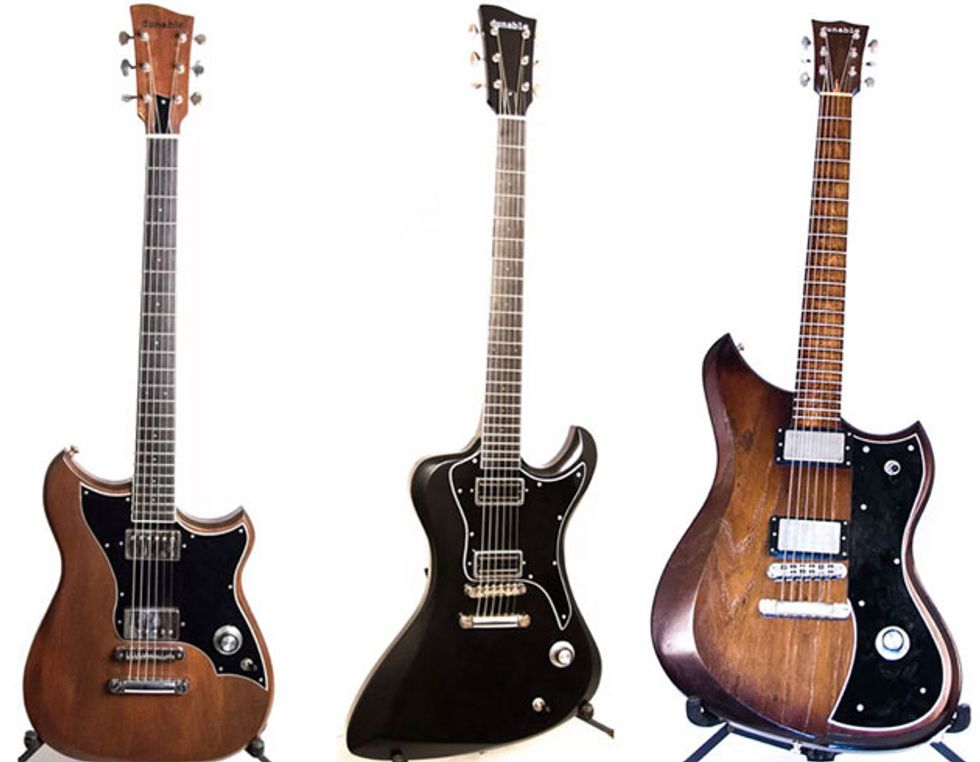





![Rig Rundown: Russian Circles’ Mike Sullivan [2025]](https://www.premierguitar.com/media-library/youtube.jpg?id=62303631&width=1245&height=700&quality=70&coordinates=0%2C0%2C0%2C0)







